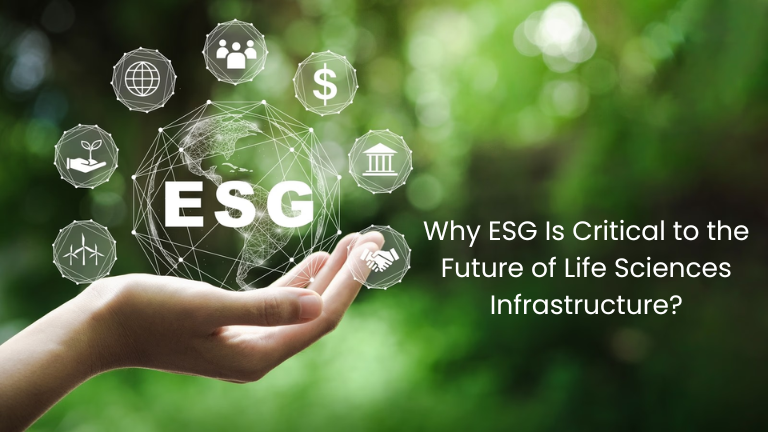
In the world of life sciences, infrastructure isn’t just about bricks and mortar — it’s increasingly a statement about sustainability, stakeholder value, and long-term resilience. As the sector pivots from cost-focused manufacturing to innovation-driven R&D, the alignment of Environmental, Social, and Governance (ESG) principles with infrastructure design and operations has become not only strategic but essential.
1. ESG is Now a Market Imperative
Today, infrastructure decisions extend beyond lab benches, clean rooms, and utility grids—they’re shaped by purpose, resilience, and responsibility. A recent report from Accenture found that the share of life sciences companies pledging full net-zero targets (covering Scopes 1, 2, and 3) rose from 25% in 2021 to 39% in 2024—yet fewer than one in four are on track to meet their operational targets¹. The average net-zero target year for life sciences companies is 2041, seven years earlier than the cross-industry average.
Similarly, Deloitte estimates that only about 20% of life sciences and healthcare firms are fully prepared for current ESG obligations². For facility owners, developers, and investors in life sciences infrastructure, this readiness gap creates latent risk — and latent opportunity.
2. Building for Regulatory and Risk Resilience
Life sciences infrastructure carries material exposure to environmental, social, and governance risks. According to KPMG, 79% of life sciences companies in EMEIA expect to increase sustainability and ESG investments over the next three years³. Meanwhile, Pharmaceutical Engineering highlights that sustainable facility design—covering energy use, waste, materials, and circularity—is now integral to pharma’s environmental sustainability agenda⁴.
When infrastructure fails to meet ESG expectations—from high energy consumption to weak supply-chain transparency—a company’s licence to operate and its investor attractiveness may both be at stake.
3. Operational Efficiency and Cost Performance
Proper ESG alignment isn’t a cost—it’s a performance strategy. For infrastructure, it can unlock efficiencies and reduce lifetime costs. Pharmaceuticals produce 55% more GHG emissions per dollar of revenue than the automotive sector⁵. Hence, it becomes imperative for companies across the life sciences value chain to rethink their operational models—from facility design to supply chain logistics—to reduce carbon intensity while maintaining scientific excellence.
In built environments, LEED-certified design, renewable energy installations, efficient HVAC systems, and circular material choices can all accelerate payback. In life sciences facilities—where energy, water, waste, and compliance represent significant line items—this becomes strategic.
4. Attracting Capital and Advancing Innovation
Investors, tenants, and partners are increasingly scoring ESG credentials. A life sciences company that fails to meet ESG expectations may face a higher cost of capital or limited access to ESG-linked financing. A recent KPMG report emphasises that companies with strong sustainability, ESG, and digital infrastructure will reap the greatest benefits and cement their position as market leaders³.
For infrastructure platforms and lab campus owners, integrating ESG into design and operations is not just a compliance measure—it’s a competitive differentiator. It signals to global pharma partners that the space is future-ready.
5. Enabling Future-Ready Life Sciences Ecosystems
Life sciences infrastructure is evolving from isolated manufacturing plants to integrated ecosystems for discovery, development, and delivery. Within these ecosystems, stakeholders—from universities and startups to CDMOs and large pharma—expect more than four walls. They expect sustainable infrastructure, digital readiness, flexibility, shared services, and responsible sourcing.
Embedding ESG frameworks from the outset allows facilities to become enablers of future life sciences models, not constraints. It paves the way for circular operations, collaborative ecosystems, and alignment with global sustainability goals.
6. Why Infrastructure Matters to ESG Outcomes
While many ESG programmes focus on operations and supply chains, infrastructure often sets the tone. Energy-intensive labs, clean-room systems, chemical storage, and logistics all depend on how a facility is designed.
A life sciences campus that integrates renewable power, optimised utilities, modular design, and waste-reduction strategies embeds ESG into its DNA. As Pharmaceutical Engineering notes, “facility design solutions are derived through science-based analyses of environmental impacts—materials, processes, services, and architecture.”⁴
Thus, infrastructure is both a lever of impact and a gatekeeper of risk.
7. From Liability to Value Creation
Too many life sciences infrastructure projects treat ESG as an afterthought. Yet the developer who views ESG as strategic transforms what might have been a liability into a value-creation engine—yielding improved tenant attraction, lower operating costs, stronger regulatory alignment, and enhanced brand equity.
Deloitte observes that sustainability in pharma is no longer a compliance burden—it’s about embedding values that deliver competitive advantage². For infrastructure professionals, this means ESG intent must guide early-stage design, location, utilities, and performance metrics.
Conclusion
The future of life sciences will not be defined by scientific innovation alone—it will be defined by how responsibly, efficiently, and sustainably that innovation is delivered. ESG is no longer a ‘nice-to-have’—it is foundational to science, capital, and reputation.
Every decision in infrastructure—from site selection and design philosophy to material sourcing and energy strategy—now directly shapes ESG outcomes. Buildings are no longer passive spaces for science; they are active enablers of sustainability, collaboration, and long-term value creation.
Facilities that integrate ESG across engineering, social responsibility, and governance will anchor the next wave of life sciences growth. As global biopharma pivots toward complex R&D, biologics, and precision manufacturing, the infrastructure supporting this growth must evolve accordingly. ESG-aligned campuses can do more than meet compliance—they can accelerate innovation, attract world-class talent, unlock green capital, and future-proof operations against regulatory and market shocks.
At Rx Propellant, we design and deliver purpose-built life sciences campuses that balance cutting-edge science with sustainability, flexibility, and future readiness. Our campuses are IFC EDGE Advanced and LEED Certified, underscoring our commitment to sustainable excellence. If you’re evaluating your next-generation R&D hub or manufacturing campus, let’s explore how our ESG-aligned infrastructure can drive long-term value.
References
1. Accenture (Nov 2024). Destination Net Zero: Accelerating Decarbonization in Life Sciences. https://www.accenture.com/in-en/insights/sustainability/destination-net-zero
2. Deloitte (Oct 2023). Embedding Environmental Sustainability into Pharma’s DNA.https://www.expresspharma.in/accelerating-pharmas-sustainability-efforts/
3. KPMG (Aug 2024). Sustainable Transformation in the Life Sciences Sector 2024 Report. https://assets.kpmg.com/content/dam/kpmg/pl/pdf/2024/08/PL-zrownowazona-transformacja-w-sektorze-life-sciences-2024-raport.pdf
4. ISPE (Mar–Apr 2023). Environmental Sustainability in Biopharmaceutical Facility Design. https://ispe.org/pharmaceutical-engineering/march-april-2023/environmental-sustainability-biopharmaceutical-facility
5. Loftware (2024). Restoring Balance: Sustainability in the Life Sciences Supply Chain. https://www.loftware.com/resources/white-papers/2024/restoring-balance-sustainability-in-the-life-sciences-supply-chain
Written By
Flydon Melrick Picardo

